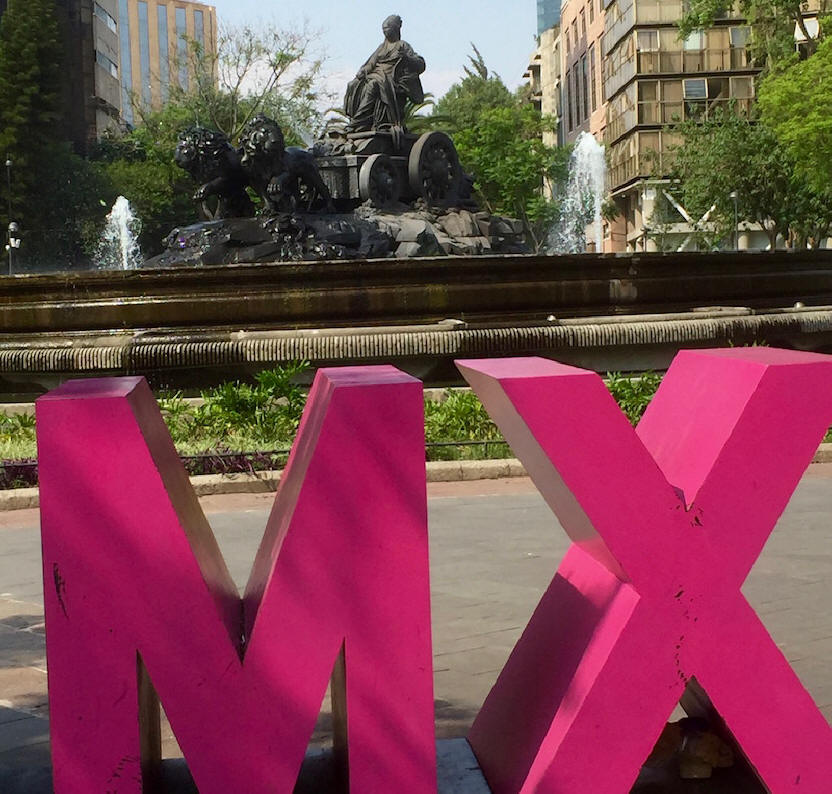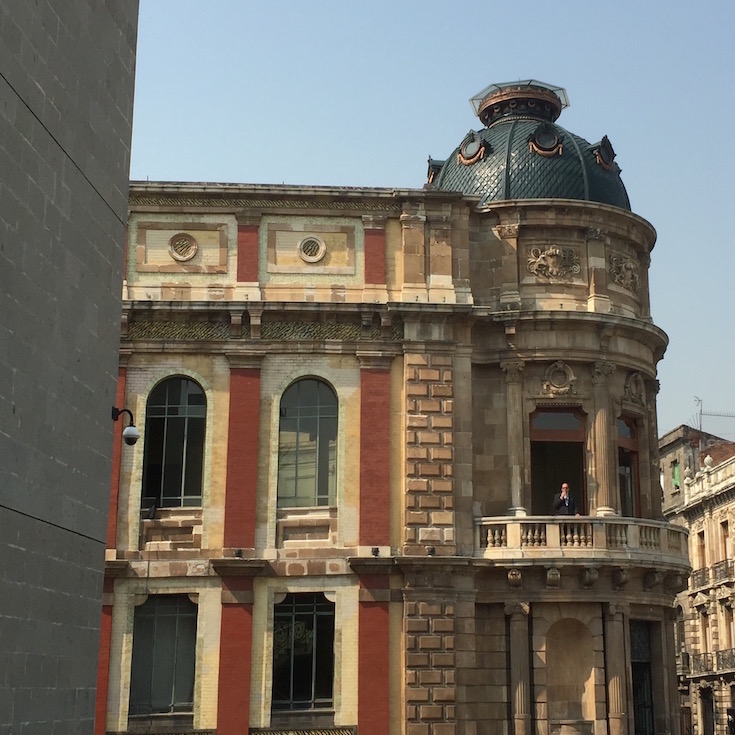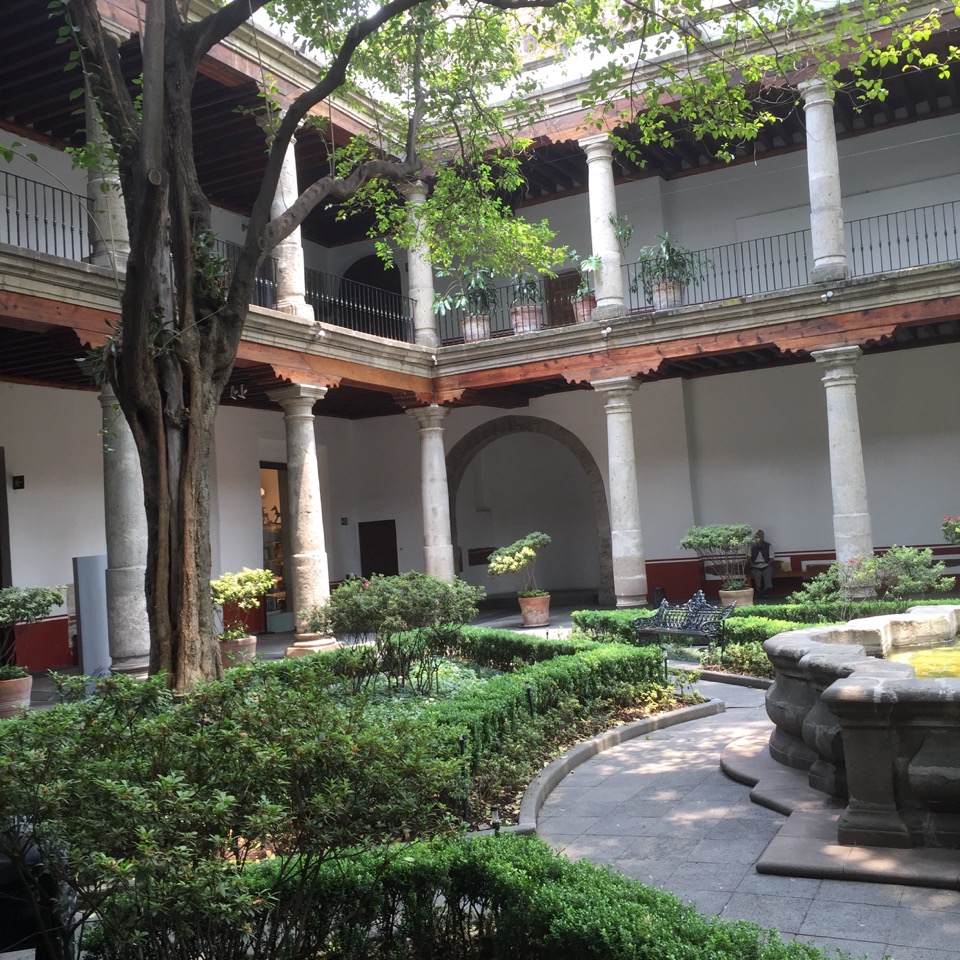
When UNESCO says a place is special --
paying attention pays off.
Perhaps your list of want-to-go-there World Heritage
Sites is as long as mine.
Mexico City captivated UNESCO – and me --
in ways both subtle and bold, abundant and ethereal and
reinforced that richness bestowing the title:
Intangible Cultural
Heritage of Humanity
New
kind of framework for shaping a trip: seeking the intangible.
It worked by opening myself to feeling the
essence of Mexico City, sensing the emotions, and perhaps
channeling the ancestors of those I met.
Stay in the
center
Reflecting takes time, and serenity. Overnighting within walking distance of many experiences
helps with that, and so does balcony sitting throughout the day
and evening with grand views to trigger insightful thoughts.

| Public art graces Mexico City
neighborhoods along with abundant greenery and
interesting architecture. |
| |
Or drinking mescal and dining on the
symbol-laden foods of Mexico that also intrigued UNESCO.
Here's where I did all that multiple times
---- Hotel Zocalo Central.
While my room was quite comfortable with ample plugs to
charge my devices and closets to keep my clothes neat, the
balcony cinched the deal.
At first I simply appreciated the expansive
view of a big and bustling plaza plus a multitude of church
spires and softly shaped tall buildings with their own, but
smaller, balconies.
After walking those streets identified from
my balcony view, I grew to appreciate the "heritage of humanity"
represented under my feet and within my sight.
Five hundred years of architecture exist side-by-side in
just one of those blocks.
A sacred place known as Temple Mayor was
built in 1325, rebuilt six times and destroyed in 1521 when the
Spanish wanted to build the cathedral also dominating the hotel
balcony view.
How's that for connecting to history over
breakfast?
 |
City streets offer invitations
to gaze from personal and hotel balconies,
as well
as to look upward toward buildings with stories to be
told. |
I would have connected further even without
venturing out because the Hotel Zocalo Central used to be
Montezuma's palace and later the residence of Hernan Cortes who
came to conquer in 1532.
Now, the 105 rooms preserve that history in
their colors, furnishings and Talavera pottery, hallway displays
present artifacts of daily life along with indigenous art and
the dining room reflects the entire food chain with artistic
presentations of Mexico's most beloved foods.
Focus first nearby
While a multitude of equally fine Mexico
City experiences require catching a ride, start first with these
closer-to-the-hotel places:
�
Temple Mayor archeological dig
and museum
�
Cathedral Metro
�
St. Teresa Convent turned art
center
�
National Palace with Diego Rivera
murals
�
Museums of Art
Temple Mayor
Observing the action in an archeological
site is like watching grass grow, right? At Temple Mayor the
results are presented in sophisticated ways in an adjoining
museum. Spectacular to stroll the walkways peering into
excavations and then encounter the 14,000 discoveries from that
exact place in exhibits both attractive and instructive.
 |
Temple Mayor in Mexico City's
central downtown combines the active
archeological
dig with a stunning museum filled with artifacts from
that site. |
Rich with symbolism, interactive in ways
sometimes to touch, often to view from many angles and always to
grasp the relationships of centuries, Temple Mayor Museum makes
sense of the vast values of archeology.
Here, the 14th century Aztec
city begins to make sense, including Cortes' descriptions of it
as a grand and sophisticated place, far more developed than the
European towns he had left to explore and conquer new worlds.
Accessing this double opportunity of dig
plus discoveries on display in the middle of a sophisticated
city, and in walking distance from my hotel, is indicative of
the depth I kept finding.
Metropolitan Cathedral
The spires of the Cathedral Metro and its
elegant fa�ade anchor the city center view from Hotel Zocalo's
balcony, but walking up to this late 16th century
structure from the side facing Temple Mayor connected me to the
history.
Historians say Hernan Cortes placed the
first stone – and it came from the Aztec temple site I had just
explored. No wonder
"Here legends are made" is repeated often by museum docents and
history-focused tour guides.
That first cathedral was demolished and the
one now to visit constructed. Keep your thoughts to yourself
because silence is emphatically requested at the front door.
Photos prohibited too.
 |
Captivating views from the
balcony of Hotel Zocalo Central toward the
Metropolitan Cathedral affirm the desire to linger and
muse. |
The Cathedral artwork and architectural
features are exquisite and abundant so I recommend a little
study ahead of time to appreciate them more.
St. Teresa Convent
Ever wondered what a convent and art center
have in common? In Mexico City, one became the other but don't
go inside if you're prone to vertigo.
This Carmelite convent launched in 1616
clearly illustrates the soft sogginess of the soil on which
Mexico City is built. The building inclines backwards, the
floors create angles and the result is disorienting.
Closed to nuns in 1863 and to the military,
universities and businesses that worked there until 1989, St.
Teresa's became an Alternative Art Center in 1989. The 1845
earthquake didn't help stability much either.
If you hesitate to experience the
almost-automatic dizziness, still go to gaze at the front: 16
Corinthian columns, the face of God in the cupola and images
representing virtues are all enlightening outside.
 |
Nine storytelling murals by
Diego Rivera present Mexico's history in
colorful,
detailed, abundant style in the National Palace in
downtown Mexico City. |
National Palace
Two reasons in one to stroll from the Hotel
Zocalo Central to Mexico City's National Palace:
architecture/landscape and nine massive Diego Rivera murals.
Enjoy the many courtyards, carved brass
balconies, arched entryways. Sit
on a bench to contemplate why Hernan Cortes demolished the
Imperial Palace built by Aztec Emperor Moctezuma (yes, also
spelled Montezuma) to build his own in 1523.
Then zoom forward to 1929 when Diego Rivera
started telling stories with murals on walls facing the handsome
double curved stairway.
History through his eyes extends from the Aztec plumed
serpent god named Quetzalcoatl through Karl Marx.
Knowing the history would enrich the
experience but if you don't, embrace the moment gazing at the
complexity of these paintings and pick out details to relate to
all your other Mexico City experiences.
I only went once, but believe starting a
holiday with the murals, returning after some museum, culinary
and archeology experiences, then exploring the city some more
and returning to the art would help process the opportunities
here to navigate cultures and centuries of life.
Museums of Art
 |
Decorative arts abound inside
the Franz Mayer Museum, and
lush greenspace invites
outdoor contemplation and relaxation. |
Also within easy reach of the hotel are
the:
�
Franz Mayer Museum abounding with
decorative art from a personal collection given to the people –
not the government – of Mexico. Allow ample time also to relax
in the front courtyard, gazing at yet another tilting building
because of the soggy soil, and the enjoy a coffee, pastry,
perhaps lunch in the back courtyard lush with greenery and
fountains.
�
MUNAL
– Museum of National Art housed in an exquisite 1902 building
designed as the Palace of Communications. Detailed friezes,
graceful marble stairway with wrought iron handrails designed by
artisans lead the way to the collection of 16th – 19th
century paintings by Mexican artists. Baroque columns and richly
painted murals on the ceilings force the eye upward as well.
�
Palacio de Belles Artes is all
about architectural wonderment and concert going. The experience
won't take long but s a good idea to round out the many moods of
Mexico City. This one's art deco and art nouveau, built in 1934.
Another story, another day? Mexico City
wonders that require a little driving.
 |
Stunning colors and stories with
depth appear all over Mexico City,
in stellar
museums, along pedestrian corridors and in neighborhoods
and hotels. |
|